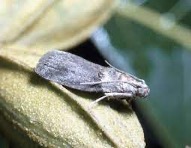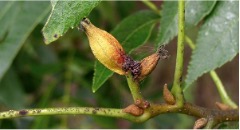Preparing for Pecan Nut Casebearer
As we dive into May, it’s time to start thinking about Pecan Nut Casebearer. Hopefully, traps for monitoring are already in place in pecan orchards or groves. If not, they need to be out as soon as possible, especially in central and northern areas of the state. Ideally, we like to get a couple of zero numbers before first capture, to identify the first flight in a specific area. Historically, this could be occurring soon in the southern part of the state.
The pecan nut casebearer, Acrobasis nuxvorella Neunzig, is one of the most devastating nut-feeding insects that occur in pecans and is found throughout pecan growing regions. In Oklahoma, adult casebearer moths generally deposit eggs during late May or early June. Eggs are deposited on the tips of nuts shortly after tree pollination. After hatching, the larvae burrow into nuts. Each larva may damage an entire cluster. The primary means of controlling this insect is the use of a well-timed application of insecticide based on infestation levels from each individual orchard.
Description
Adult casebearer moths (Fig. 1) are gray to dark gray, have a dark ridge of scales on the forewings, and are about 1/3 inch in length.
| Image | Caption |
|---|---|
 |
Figure 1. Adult Casebearer. |
 |
Figure 2. Egg laying on nutlet. |
In Oklahoma, the pecan nut casebearer completes two to three generations per year. Overwintering larvae develop into pupae, and ultimately moths emerge after pollination. Female casebearer moths begin laying eggs on pecan nuts (Fig. 2), resulting in first-generation larvae that feed on pecan nuts and generally cause the most damage. (Fig. 3).
| Image | Caption |
|---|---|
 |
Figure 3. PNC Larvae Damage. |
Second-generation PNC begin appearing ≈ 45 days after first generation, feeding primarily on pecan shucks. Unless populations are extremely high, little damage is created from second or third generation larvae. Egg-laying by PNC begins around the end of May in southern counties and ranges to June 15 in northern parts of the state. Excessive rainfall or cold temperatures may delay development of the overwintering generation.
Scouting
Scouting for PNC should begin one to two weeks before nut entry by larvae. A cluster is infested if eggs are found, or evidence of larval entry is observed. Examine 10 nut clusters per tree across several trees. If 2 or more clusters are infested before 310 clusters have been examined, an insecticide application should be made as soon as possible. If less than two clusters are found infested, sampling should be repeated in two to three days.
Pheromone traps
Pheromone-baited traps for PNC are available. The pheromone (sex attractant) mimics the chemical emitted by female casebearer moths and attracts males to a sticky trap. Trap captures can be used to detect the arrival of PNC into an area, aid the grower in estimating population numbers, and provide a signal of when the first significant nut entry by larvae may occur (Fig. 4-5).
Figure
| Image | Caption |
|---|---|
 |
Figure 4. Pheromone Kit. |
 |
Figure 5. Adult moths on sticky insert. |
As a general guide, three to five pheromone traps are sufficient in determining emergence patterns of PNC moths. Three traps for orchards of 30 to 50 acres and five traps for orchards in excess of 50 acres should suffice. Consider additional traps where orchard conditions vary, such as bottomland versus upland areas. Get traps out as early as possible after May 1 to identify the first flight.
Based on university research, we suggest that scouting begin seven to ten days after the capture of the first PNC moth(s). This allows plenty of time to anticipate the first significant nut entry, which should occur 12 to 16 days after initial moth capture.
Scout regularly. A heavy moth flight may not necessarily translate into a successful and/or heavy oviposition (egg-laying) cycle. In Oklahoma, during the period that mating and subsequent oviposition occurs, moths are exposed to many environmental influences that can affect survival and successful propagation.
Insecticide applications should be properly timed to achieve the best control. Whenever possible, biological insecticides or insect growth regulators (IGR), MoA group 18, should be used for controlling PNC instead of synthetic pyrethroids, carbamates, or organophosphates. The latter materials, while effective, can result in reduction of parasite and predator populations. Due to loss of beneficial organisms, this increases the possibility of rapid population growth of aphids and spider mites. In addition, carbamate and pyrethroid insecticides can be reserved for pecan weevil control later in the growing season where efficacy of these compounds is essential for control.
More information on the pecan nut casebearer and it’s control can be found at EPP-7189, The Pecan Nut Casebearer andCR-6209, Commercial Pecan Insect and Disease Control
